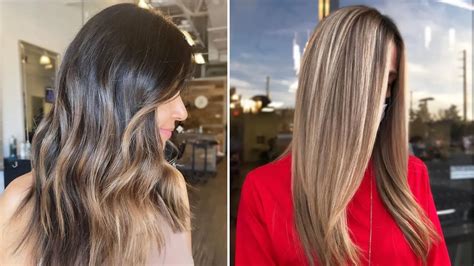Introduction
In the world of hair coloring, two prevalent techniques reign supreme: balayage and highlights. Each method imparts a unique aesthetic, offering distinct advantages and drawbacks. This comprehensive guide delves into the intricate details of both techniques, empowering you to make an informed decision for your next hair transformation.

Balayage vs Highlights: Uncovering the Key Differences
1. Application Method
-
Balayage:
- Freehand painting technique
- Color is applied directly to specific sections of hair
- Creates a soft, natural-looking gradient
-
Highlights:
- Traditional foil or cap method
- Color is separated from the rest of the hair using foils or a cap
- Produces more intense, defined streaks
2. Resulting Effect
-
Balayage:
- Sun-kissed, blended look
- Less noticeable regrowth lines
- Adds depth and dimension to natural hair color
-
Highlights:
- Contrasting streaks of color
- More uniform, even distribution
- Can be tailored to create bold or subtle effects
3. Suitability
-
Balayage:
- Suitable for all hair colors
- Ideal for creating a low-maintenance, natural look
- Blends well with gray hair
-
Highlights:
- Complementary to darker hair colors
- Can create a more dramatic, eye-catching effect
- May require more frequent maintenance
Balayage vs Highlights: Pros and Cons
Balayage: Pros
- Natural-looking, sun-kissed effect
- Low maintenance, with less noticeable regrowth
- Adds depth and dimension to hair color
- Suitable for all hair textures and colors
- Can conceal gray hair effectively
Balayage: Cons
- Time-consuming application process
- Requires a skilled hair colorist
- Can be more expensive than highlights
- May not provide as much contrast as highlights
Highlights: Pros
- Bold, defined streaks of color
- More customizable, allowing for varying widths and intensities
- Can create a dramatic, eye-catching effect
- Relatively affordable compared to balayage
Highlights: Cons
- High maintenance, requiring frequent touch-ups
- More noticeable regrowth lines
- Can damage hair more than balayage
- May not suit all hair colors or textures
Choosing the Right Hair Coloring Technique for You
The choice between balayage and highlights ultimately depends on your personal preferences and hair goals. Consider the following factors:
- Desired effect: Do you prefer a subtle, natural look or more dramatic, contrasting streaks?
- Hair color: Can your natural hair color support the desired technique?
- Maintenance level: Are you willing to invest time and effort in maintaining your hair color?
- Budget: How much are you willing to spend on hair coloring services?
Balayage and Highlights: A Comparative Table
| Feature | Balayage | Highlights |
|---|---|---|
| Application Method | Freehand painting | Foil or cap |
| Resulting Effect | Sun-kissed, blended | Contrasting streaks |
| Suitability | All hair colors | Darker hair colors |
| Maintenance Level | Low | High |
| Cost | More expensive | Less expensive |
| Naturalness | High | Low |
| Damage Level | Low | Moderate |
Balayage and Highlights: A Step-by-Step Approach
Balayage:
- Hair is sectioned.
- Color is applied directly to selected sections using a brush or comb.
- Color is blended into the natural hair using feathering techniques.
- Processing time varies depending on hair type and desired results.
Highlights:
- Hair is divided into sections using foils or a cap.
- Color is applied to the exposed hair through the holes in the foils or cap.
- Foils are folded and sealed to isolate the color-treated strands.
- Processing time varies depending on hair type and desired results.
Frequently Asked Questions (FAQs)
1. Which technique damages hair less?
Balayage is generally considered less damaging than highlights.
2. How often should I get balayage or highlights?
The frequency of touch-ups depends on the desired effect and hair growth rate. Typically, 3-6 months is recommended.
3. Can I do balayage or highlights at home?
Professional hair colorists recommend seeking a trained hairstylist for these techniques.
4. How much do balayage and highlights cost?
Costs vary based on location, hair length, and hair colorist experience.
5. How long does balayage or highlights take?
Balayage takes longer than highlights, typically ranging from 2-4 hours.
6. Can I mix balayage and highlights?
Yes, some hairstylists use a combination of techniques to create a customized look.
Conclusion
Balayage and highlights are two versatile hair coloring techniques that offer distinct aesthetic benefits. By understanding their differences, pros, and cons, you can make an informed decision about which technique best suits your hair goals. Whether you seek a natural, sun-kissed look or bold, contrasting streaks, consulting with a professional hair colorist is crucial to achieve your desired result.
